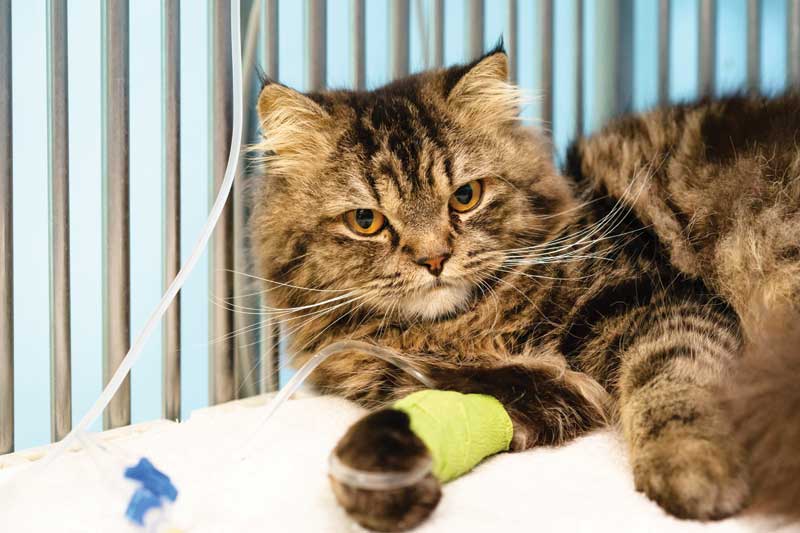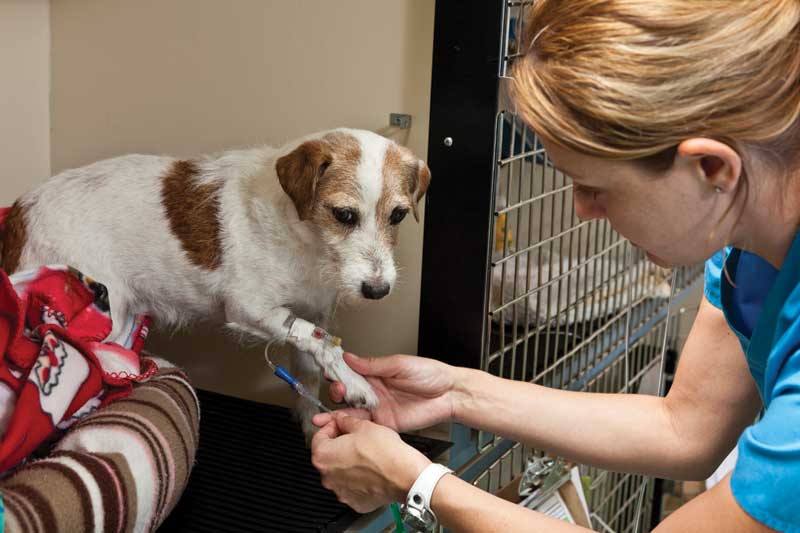
In companion animals, toxin or toxicant ingestion is a very common reason for emergency visits. Primary treatment goals are acute decontamination and detoxification, followed by symptomatic and supportive care. Due to the short window of time for common decontamination techniques (emesis induction, activated charcoal), other techniques are sometimes necessary for the survival of the intoxicated pet.
Intravenous lipid emulsions (ILEs) represent a valuable, cheap, and life-saving alternative to other more complicated and expensive treatments after ingestion of a lipophilic toxin or toxicant. Selecting the right patient for ILEs is vital for the success of the treatment.
While ILEs have always played an important role in parenteral nutrition, their use in toxicology is more recent. In humans, the first reported use of ILEs to treat local anesthetic-induced cardiotoxicity only dates to 2006. In 2008, the use of ILEs was then successfully expanded to other lipophilic toxins. While ILEs remain a “rescue” treatment in severe human poisoning cases, its use in veterinary medicine has significantly grown over the last decade.
Although further studies are needed to fully evaluate the safety and effectiveness of ILEs, many studies have already demonstrated its value in the treatment of multiple lipophilic drug toxicities.
What are ILEs?
ILEs contain long-chain, fatty acids originally formulated for parenteral nutrition. With a long shelf-life (up to two years) and a relative cheap price, they represent a very affordable treatment option for intoxicated pets. A commonly used ILE is an emulsion containing 20 percent soybean oil that provides a mixture of omega-6, omega-3, and omega-9 fatty acids. Its osmolarity is 260 mOsm/L and ILEs can, therefore, be administered safely in peripheral veins. Once open, the bag can be stored for up to 24 hours in a fridge.
The exact mechanism of action of ILEs remains unknown despite multiple proposed theories. The most widely accepted one is the “lipid sink” theory. It hypothesizes that lipid emulsions circulating in the intravascular space offer a compartment for lipophilic drugs to partition into, making these drugs unavailable to their target organs. Moreover, in addition to sequestering drugs, this created lipid compartment helps accelerate their movement from drug-susceptible organs (heart, brain) toward organs responsible for their metabolism and excretion. An alternative theory hypothesizes ILEs have direct effect on myocardial cells and can, therefore, improve cardiac output. The mechanism behind these cardiac effects has not been fully elucidated yet. Yet,it is thought fatty acids could either provide a direct source of energy to the myocardial cells or could cause an increase calcium influx within myocardial cells, improving cardiac contractility.

When should ILEs be considered?
First and foremost, ILEs should only be considered in lipid soluble toxins or toxicants. Lipophilicity of drugs is expressed as the partitioning coefficient (log P). The higher log P value, the more lipophilic an agent is. Moreover, like any decontamination or detoxification techniques, ILEs should be reserved for patients that ingested a substance associated with life-threatening clinical signs or a lethal dose of it. ILEs can be administered in patients that are still asymptomatic or in patients already showing clinical signs, ranging from mild to severe.
ILEs can be used alone or in combination with gastrointestinal decontamination (GID) procedures (induction of emesis, activated charcoal). When combining GID and ILEs, ILEs will help with already absorbed toxins/toxicants, while GID will prevent further drugs absorption through the gastrointestinal tract. In the event the toxins or toxicants have already been absorbed through the skin or gastrointestinal tract, or if the toxicant has been directly injected intravenously, GID are not indicated and ILEs should be considered instead. In addition, when GID procedures are ineffective in removing the ingested toxins or unsafe for the patient, ILEs also offer a valuable alternative and should be initiated without delay.
In veterinary medicine, published evidence supports the use of ILEs to treat intoxicated patients. Toxins and toxicants that have been successfully treated with ILEs include local anesthetics, ivermectin, moxidectin, permethrin, baclofen, NSAIDs (ibuprofen, naproxen), marijuana, cholecalciferol, bromethalin, tremorgenic mycotoxins, THC, methamphetamine, and calcium channel blockers. Despite this long list of known toxins and toxicants that have responded to ILEs treatment, it should be remembered that ILEs could theoretically work for any lipophilic toxins and toxicants.
Administration considerations
In veterinary medicine, the ideal administration protocol remains unknown, and dosage has been mostly extrapolated from human medicine. ILEs is administered intravenously through an intravenous catheter (peripheral or central). An initial bolus of 1.5 ml/kg is usually given over two to five minutes. The bolus is immediately followed by a constant rate infusion of 0.25 ml/kg/min for 30 to 60 minutes.
If a risk of volume overload exists, it is reasonable to discontinue all other infusions during ILEs administration. Moreover, a slower rate (0.07 ml/kg/min) can also be considered for four hours.
While administering ILEs, a close monitoring of the patient is recommended to assess for possible pyrogenic and allergic responses, especially in the first 20 minutes. If any reaction occurs, ILEs administration should be stopped. The intoxicated patient should be evaluated every four to six hours after ILEs administration.
For safety reason, a maximum total dose of 16.5 ml/kg/hr of ILEs should not be exceeded.
Redosing ILEs should be considered in the following situations: 1) patient has originally improved after the ILEs but is now getting worse again, 2) the patient has not shown the expected clinical improvement.
Side and adverse effects
When administering ILEs to an intoxicated pet, it is important to remember ILEs can impact your ability to treat that patient with other drugs. If the drug needed for supportive care is a lipophilic drug, it will be affected the same way as the toxin you are treating.
After ILEs, the resulting hyperlipidemia can also interfere with common laboratory testing and can prevent a normal blood work assessment of your patient.
Adverse effects are very rare. It is important to understand most adverse effects reported in human medicine are associated with prolonged used of ILEs for parenteral nutrition. These adverse effects include microbial contamination, allergic or anaphylactic reactions, volume overload, swelling after extravasation, fat embolism, and pancreatitis. No adverse effects have been documented for the use of ILEs as an antidote for lipid-soluble drug toxicities in humans.
Hyperlipidemia is observed in most patients receiving ILEs. It is rarely associated with any clinical signs, and it can be monitored on visual inspection of serial centrifuged hematocrit tubes.
In veterinary medicine, so far, only three case reports have documented ILEs associated adverse effects. In two cases, cats demonstrated transient corneal lipidosis, which resolved without treatment within a few days. The third reported case was a dog that developed acute lung injury following administration of ILEs. The dog was, however, concurrently treated with a lot of other medications.
ILEs represent a cheap and easy option to use in patients that ingested a lipophilic toxin. Based on their mechanism of action, it is important to remember ILEs will help with toxins that have already been absorbed through the GI tract and therefore should not replace conventional GI decontamination techniques.
It is time to add ILEs to your list of tools to fight toxicities. Who doesn’t like a cheap and easy life-saving tool?
Virginie Wurlod, Dr. vet. Med. DACVECC, DECVECC, is an associate professor in small animal Emergency and Critical Care (ECC) at the Louisiana State University. Dr. Wurlod is originally from Switzerland, where she did her initial veterinary training, before pursuing an ECC residency in the U.S.
References
- Robben JH, Dijkman MA. Lipid Therapy for Intoxications. Vet Clin North Am Small Anim Pract. 2017 Mar;47(2):435-450.
- Gwaltney-Brant S, Meadows I. Use of Intravenous Lipid Emulsions for Treating Certain Poisoning Cases in Small Animals. Vet Clin North Am Small Anim Pract. 2012 Mar;42(2):251-62
- Rothschild L, Bern S, Oswald S et al. Scand J Trauma Resusc Emerg Med. 2010 Oct 5;18:51
